Traditional German Spaetzle Recipe
This post may contain affiliate links. See my disclosure policy.
One of Germany’s most popular and beloved foods, here is a fool-proof and authentic German Spaetzle recipe, just the way my Mutti and Oma made it! Perfect texture and perfect flavor, these are just like you know and love them from the Swabia region of Southern Germany where they originated!
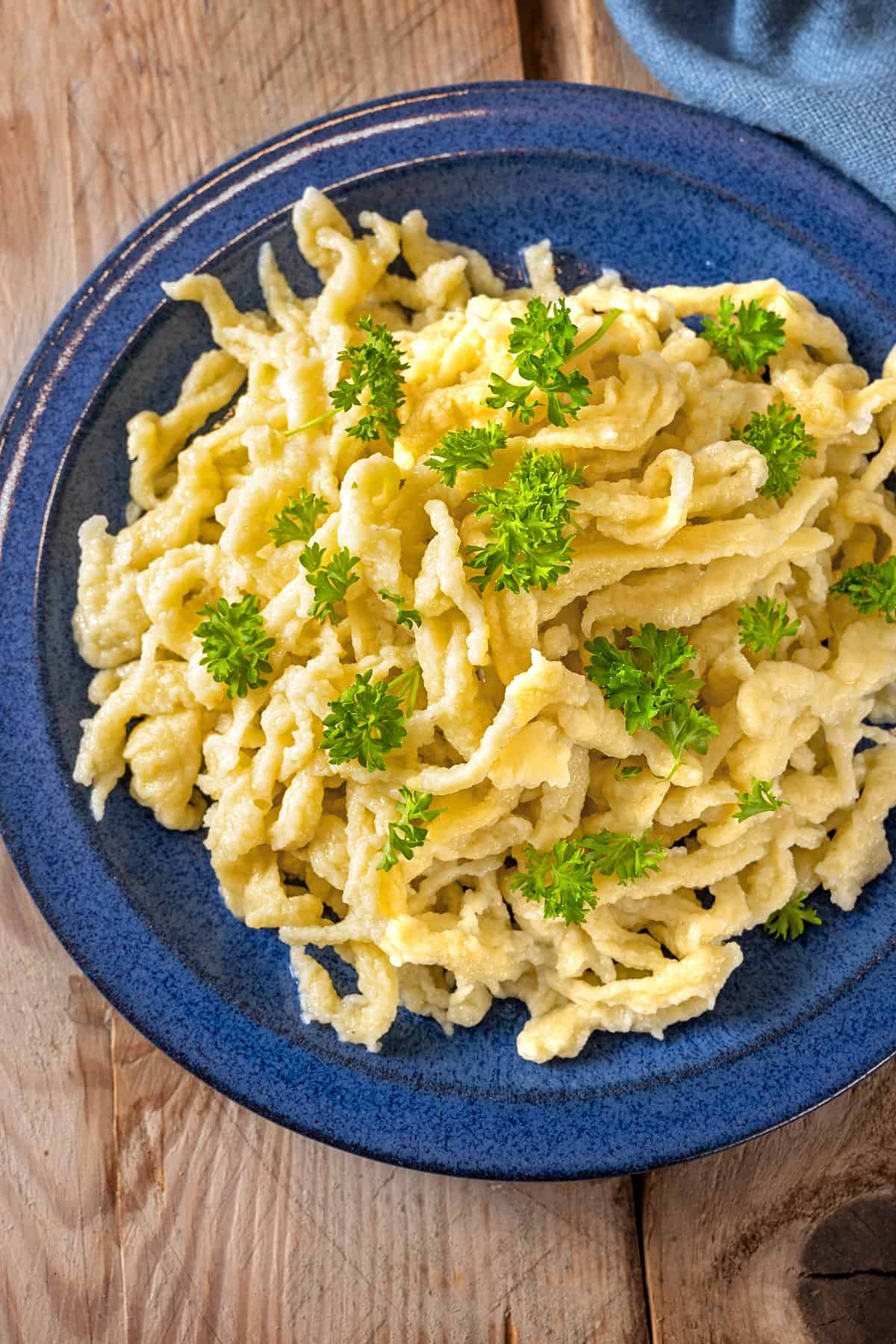
What is Spaetzle?
One of the most beloved foods in Germany that tourists go home talking about is Spaetzle, the famous German egg noodles from the Baden-Württemberg region of southwest Germany. This area is also known as Schwabenland, or Swabia. I grew up in Stuttgart, the capital of Baden-Württemberg, watching my Mom and Oma make Spätzle – I learned from the best!
Swabia is home to some of Germany’s best food (many, including myself, will argue it’s home to the best food in all of Germany). And that’s saying a lot because every region of Germany has amazing food. Swabia is known for its soups, sauces, meats, wursts, and salads, to name a few. It’s also home to some unique varieties of pasta including Spätzle, Schupfnudeln and Maultaschen.
Today we’re featuring Spätzle, a Swabian specialty that is also enjoyed in Austria and Switzerland. Spaetzle is a special type of egg noodle that is enjoyed with sauces and gravies as well as incorporated into a variety of different dishes. One example is Käsespätzle (a cheese spatzle casserole with crispy fried onions). Where did the name “Spätzle” originate? It comes from the German word Spatzen, meaning “little sparrows”, because that’s what they were thought to resemble when they were traditionally made by hand.
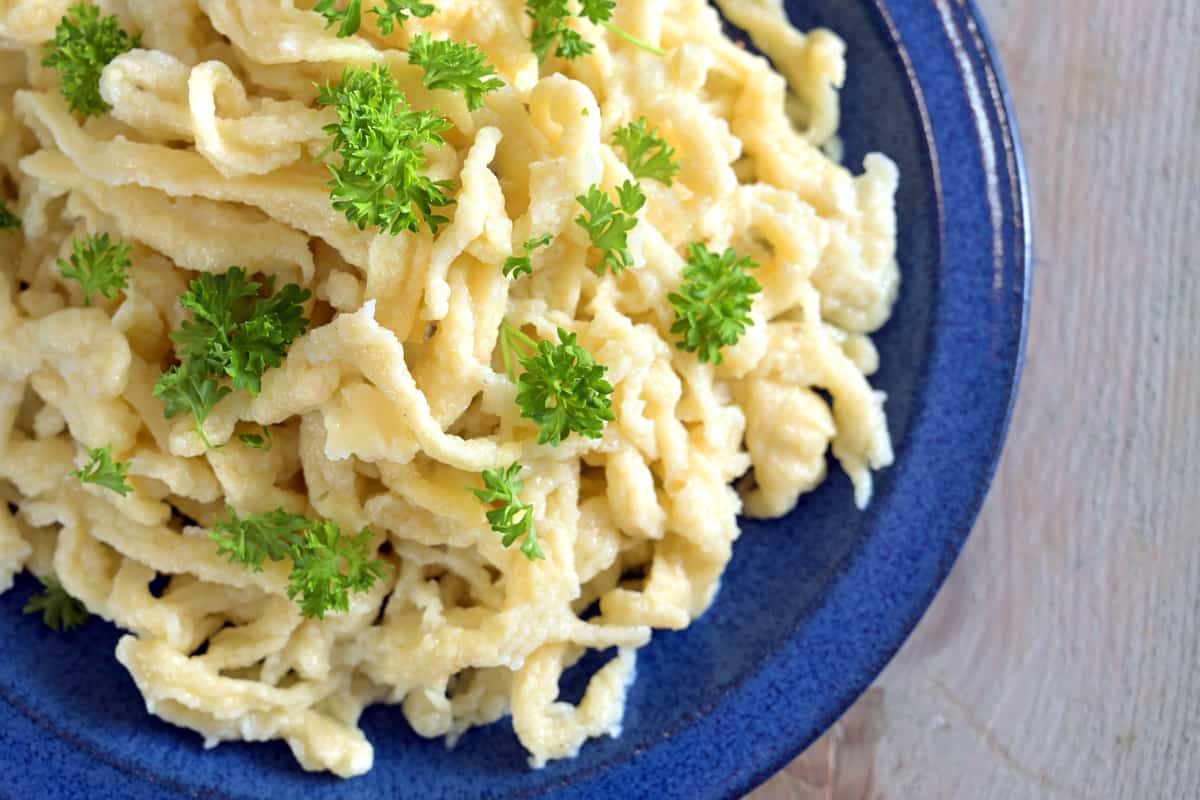
Spaetzle Ingredients
Spaetzle is a type of pasta and as such is made with a very few, simple ingredients that you’ll already have in your pantry. Here’s what you need:
- All-purpose flour: this creates a tender Spaetzle that still has a nice chewy texture.
- Eggs: these add richness and contribute to texture.
- Milk or water: You can use either but I prefer milk as it adds richness.
- Salt: enhances the flavor.
- Nutmeg: this is optional and is not traditional, though many German cooks today like to add it for flavor.
Spaetzle Recipe
Let’s get started!
This spaetzle recipe uses a stand mixer to knead/mix the dough. This is actually the first time I’ve made it that way. I’ve always done it by hand (you “knead” it by vigorously whipping it in a bowl with a spoon – over and over and over for around 20 minutes. It’s a lot of work!) I decided to to try it with a stand mixer instead and it turned every bit as good – and it sure saves a lot of muscle strain!
Add the flour and salt in the bowl of a stand mixer. Stir to combine. Crack four eggs into a bowl and whisk to combine. Make a well in the center of the flour and add the eggs. Add the milk or water and with the paddle attachment (I initially tried the dough hook and it didn’t work well), knead/mix the dough on the “2” setting for about 10 minutes to get a cohesive batter. Add more flour if the mixture is too runny, or more milk if it is too stiff.
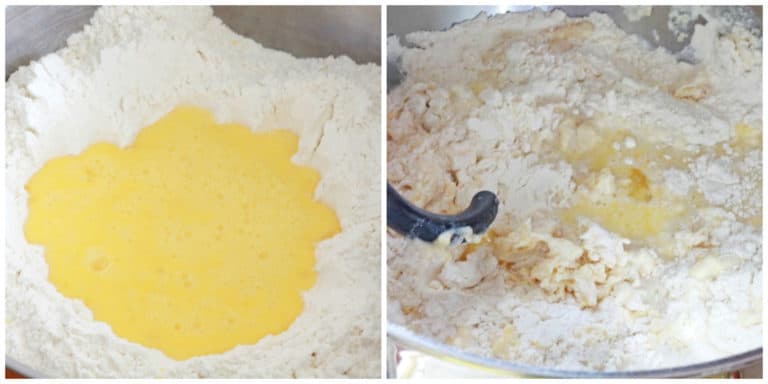
Pro Tip: How to Know When the Spätzle Batter is Ready
The batter is done when “bubbles” begin to form. After about 10 minutes of beating, use a wooden spoon and scoop and pull to stretch the batter; if bubbly holes appear, the dough is done. If not, continue “kneading” with the mixer for another minute or two, repeating the “test” process. See the bubble hole below?
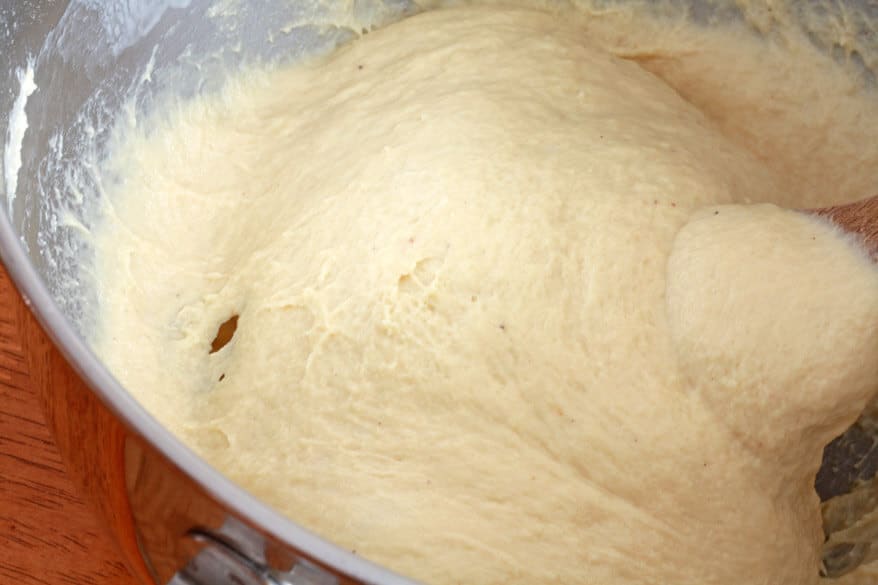
When those bubbly holes start appearing you know your batter is done.
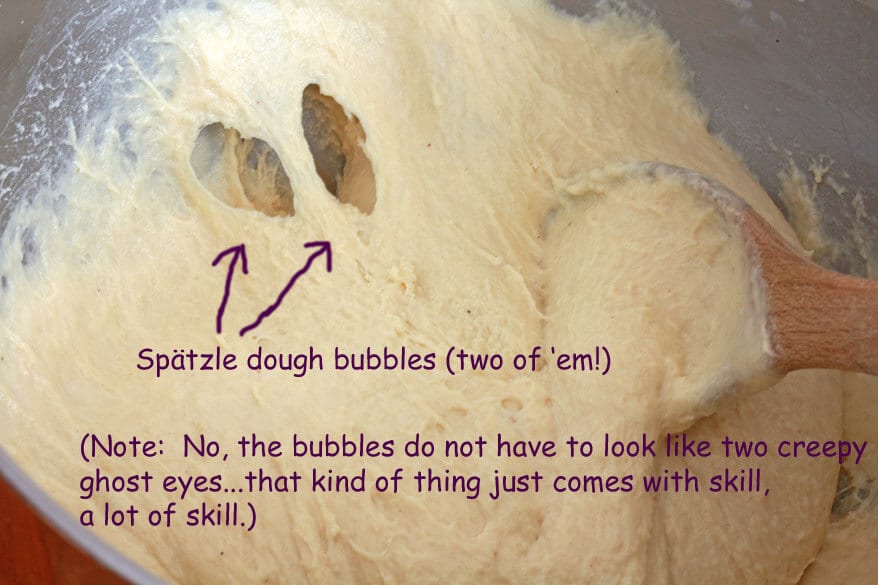
What Is the Best Spätzle Maker?
Now that the batter is read it’s time to make the Spätzle. And when it comes to the Spaetzle maker, there are a few options to choose from. Traditionally, Spätzle was made by hand using a Spätzlebrett, or Spaetzle board. You would rub a slab of dough out onto a wetted board and use a pastry cutter or long sharp knife to quickly cut off strands of the dough into simmering water. Swabian women of previous generations were highly skilled at this and could do it so fast it would make you dizzy to watch. Nowadays most Germans use a Spätzle maker (and even more just buy it ready made at the store. It’s the “convenience generation”).
Besides the traditional Spätzle board there are a few different kinds of Spätzle makers out there that you can find online:
- Spätzle Press (below left): That is my Spaetzle maker that I brought with me from Germany when I moved to the U.S. and it’s awesome. This kind is pricey but it will last a lifetime. It’s called the Original Kull Spätzle Maker and is made in Germany. It’s built like a tank and will become a family heirloom you can pass down for generations. Another brand that is much cheaper and is also made in Germany is this Westmark Spätzle Maker. These Spätzle presses can also be used as potato ricers.
- Spätzle Scraper (below right): Another option is the Küchenprofi Spätzle Lid & Scraper. I’ve used this one as well with good results and it’s much cheaper. It produces a shorter, stubbier spatzle noodle. Alternatively you can also use a metal steamer because it’s similarly constructed with large holes. You place some of the dough in the steamer over the simmering water and scrape the dough through the holes.
- Spätzle Plane: A third option is the Küchenprofi Spätzle Plane with Pusher, which is my least favorite as it can be a little clumsy, messy, and more difficult to work with but I know people who use it.
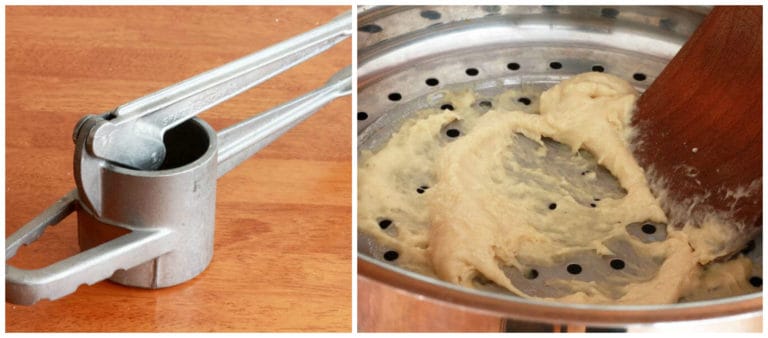
My personal favorite is the Spätzle press and that’s what I’m using in the pictures below. Place the Spaetzle maker over a pot of lightly salted simmering water and scoop some dough into it.
Press the Spätzle maker down to squeeze the Spätzle noodles out into the simmering water. Simmer the Spätzle for about 2-3 minutes or until they float to the top.
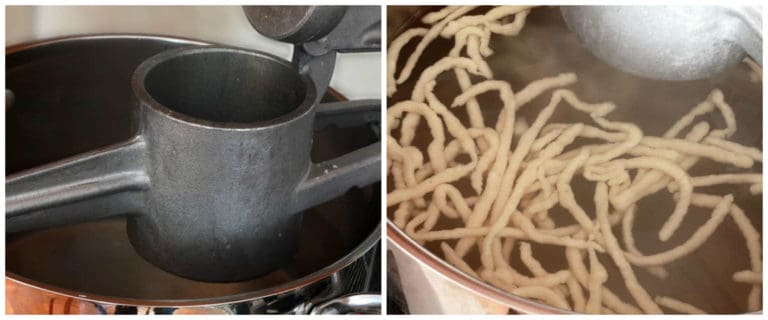
Using a slotted spoon, transfer the Spätzle to a colander and then immediately put them in a bowl of very cold water. This helps them firm up to the desired consistency.
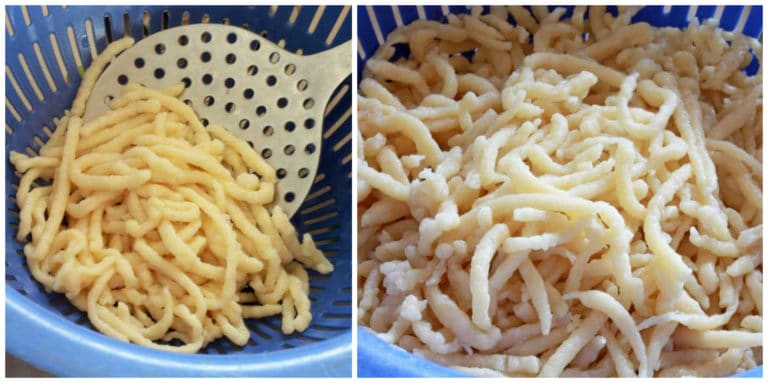
Drain the Spätzle again and toss with a little oil or melted butter to keep them from sticking.
Spätzle will keep in the fridge for at least a couple of days and then heated to serve. Melt some butter in a pan and toss the Spaetzle in it to warm through.
Storage & Freezing
Spaetzle can be made in advance, cooled, and stored in a covered container in the fridge where it will keep for 3-4 days. To reheat it you can microwave it in a microwave-safe container or, my favorite way, is to melt some butter in a large skillet, add the Spätzle and heat through. Spaetzle also freezes well for up 3 months: put it in a freezer-safe container and let it thaw overnight in the fridge. It can be reheated in the microwave in a covered container so that it doesn’t dry out, or you can melt some butter in a pan and toss the Spaetzle in it until warmed through.
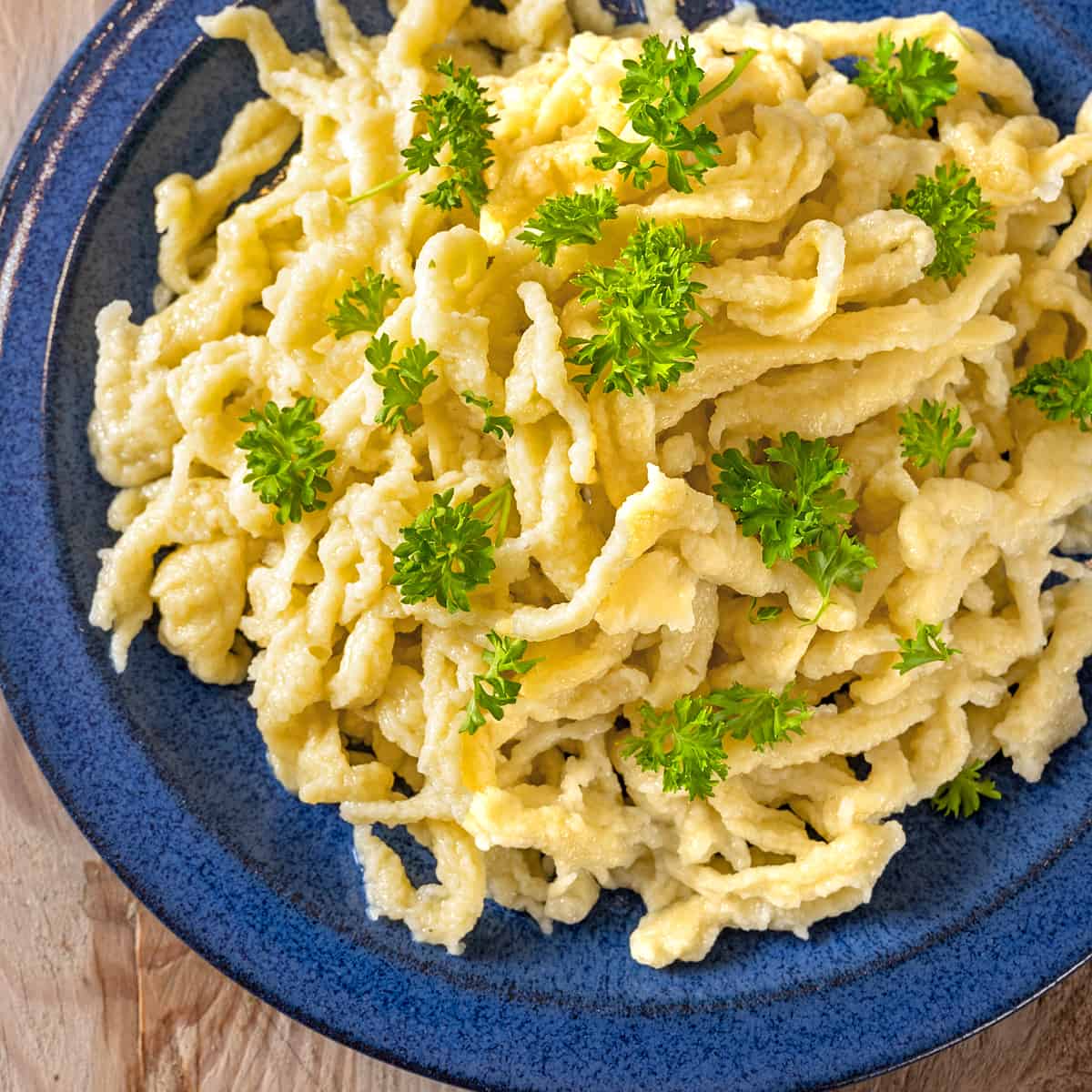
What to Serve with Spaetzle
Spaetzle is very versatile and can be served a variety of ways. Here are a ways to serve spaetzle:
- Buttered Spätzle: This is one of the simplest and most traditional ways to serve spaetzle. After boiling and draining the cooked spaetzle, toss them with melted butter and sprinkle with chopped parsley.
- German Cheese Spaetzle (Käsespätzle): Another Swabian classic and personal favorite, try my recipe for Käsespätzle (pictured below).
- With Sauces and Gravies: Spaetzle can be served with any sauce or gravy, like my favorite German Rahm Sauce, Onion Gravy, or Mushroom Gravy. Serve it with my classic German Goulash, Geschnetzeltes or Königsberger Klopse.
- With Meat Dishes: Spaetzle is the perfect choice to serve with any saucy meat dish like Jagerschnitzel, Rouladen, Sauerbraten, Pot Roast and Tri Tip Roast. It can also accompany your Schweinshaxe and Frikadellen.
- Pasta Salads: For a variation on traditional pasta salad, toss the spaetzle with fresh vegetables, herbs, a vinaigrette, and some diced cheese and ham.
- In Soups: In some regions, spaetzle is added to soups, much like dumplings. Drop small portions of spaetzle dough directly into simmering soup and let them cook until they float to the surface as in this Gaisburger Marsch and German Pea Soup.
Guten Appetit!
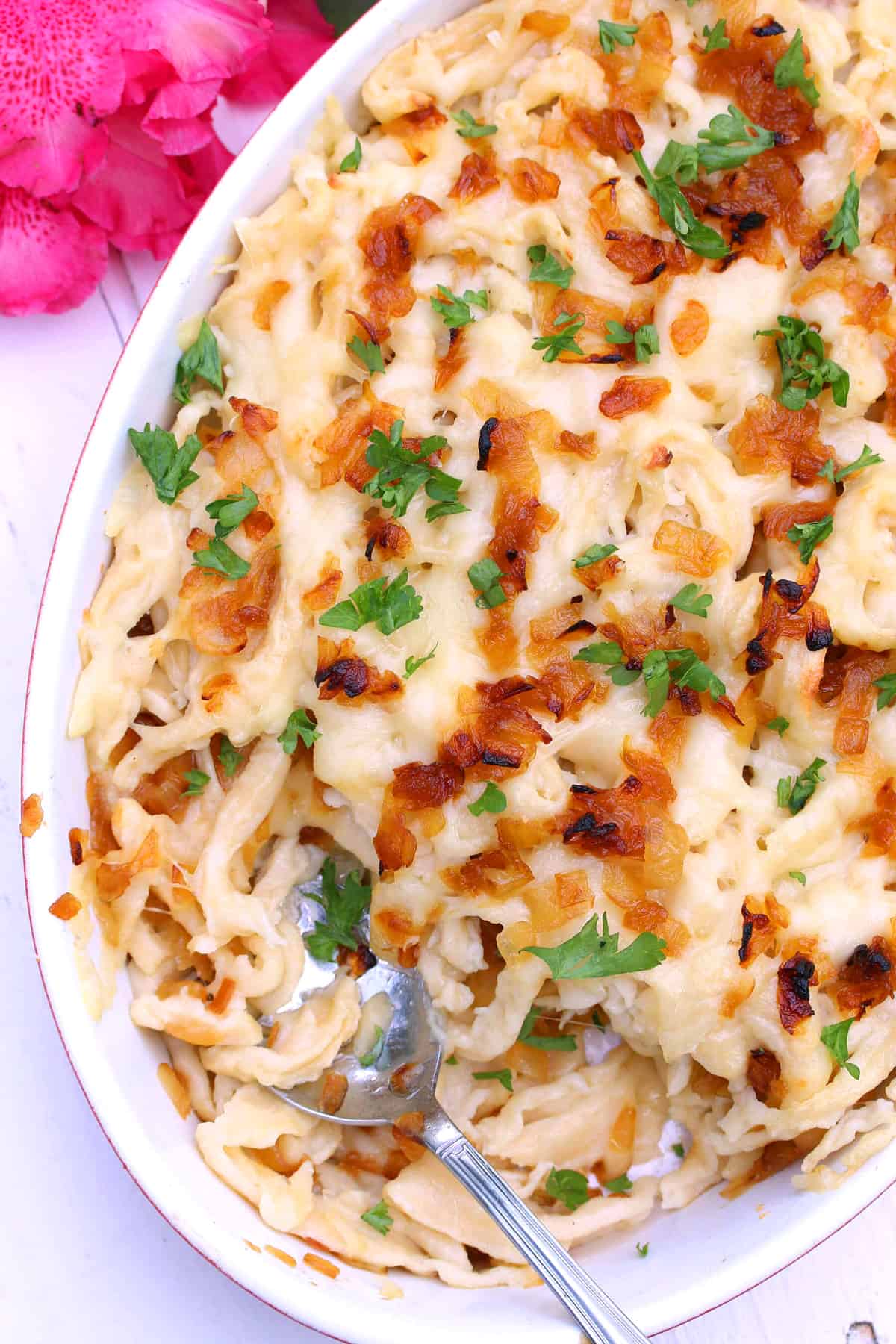
For more favorite traditional German dishes be sure to try my:
- Kaesespaetzle
- Rouladen
- Sauerbraten
- German Goulash
- Maultaschen
- Schnitzel
- Bread Dumplings
- German Potato Dumplings
- Zwiebelkuchen
- German Bread (Vollkornbrot)
- Bratwurst
- Currywurst
- German Potato Salad
- Rotkohl
Save This Recipe
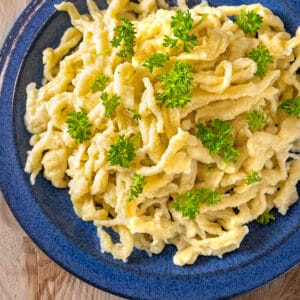
Traditional German Spaetzle Recipe
Equipment
Ingredients
- 2 cups all-purpose flour (you can also use whole wheat flour)
- 1 1/2 teaspoons salt
- 1/8 teaspoon freshly ground nutmeg , optional (not traditional but adds a nice flavor)
- 4 large eggs
- 1/2 cup milk or water + more as needed (milk produces a richer Spaetzle) (**add more flour if the dough is too runny, add more milk or water if it's too stiff)
- butter for serving
Instructions
- The Spätzle batter can be mixed by hand or by using a stand mixer which is much easier. Add the flour, salt and nutmeg (if using) to the bowl of a stand mixer. Stir to combine. Crack the eggs into a small bowl and whisk them. Make a well in the center of the flour mixture and pour the eggs in it. Add the milk (start with using slightly less and add more as needed). Attach a paddle attachment to the stand mixer and "knead" the dough for about 10 minutes or until bubbles appear (see pictured instructions for details). After 10 minutes or so of beating, use a wooden spoon to scoop and pull the dough. If bubbles/holes appear, the dough is done
- Bring at least 2 quarts of lightly salted water to a boil, then reduce to a simmer. Using a Spätzle maker of your choice (I use and prefer the Spätzle press), press the noodles into the simmering water and cook for about 2-3 minutes, or until the noodles float to the top. Use a slotted spoon to transfer the noodles to a colander to drain the hot water and then to large bowl of ice water (this firms them up for a better/chewier texture). After a minute or two transfer them to a colander to drain completely. Before serving, warm them through in a skillet with some melted butter.
- Make Ahead: The Spaetzle can be stored in the fridge for at least a couple of days and then reheated. Melt some butter in a large skillet and toss the Spätzle in it to heat through. Alternatively they can be microwaved in a covered dish.
Notes
Nutrition
Originally published on The Daring Gourmet on August 3, 2013



















Yes, it was too wet. I didn’t want to add more flour so I just pulled out the spaeztle maker instead!
I received a nockerl maker for Christmas. I have my mom’s Original Spaetzle maker but when I used the same recipe with the nockerl maker it did not work. Do you know the ratio of dry to liquid for this type of maker? It would be great with your Hungarian Goulash recipe.
Hi Helga, it depends on whether the reason it didn’t work is because the dough was too wet or the dough was too tough for the nockerl maker. If it’s too tough, simply add a little more water until you reach the consistency that works. If it’s too wet, reduce the water by a little.
Love your newsletter and recipes. I just have to mention, I learned to make spatzle from my grandmother (Swiss/Austrian). Love that the timing for when they are done cooking is “The pot boils over twice.” However, I have tried a spatzle maker once or twice and it was a horrible mess. I still do the way she taught me, scrape little bits into the water from the edge of the mixing bowl with a soup spoon. Some are big, some a small, but it works fine.
I’m from Augsburg and LOVE your recipes!
Vielen Dank, Dagmar! <3
This is the best recipe! I made it exactly as written. I used a previously owned but perfect Kull Spaetzle press purchased on eBay for about $44 including shipping. The holes were smaller than I expected, and it took some effort to press the dough. The noodles expanded when they cooked, so they looked perfect. I rinsed the Kull with a little water from time to time, which made the pressing a little easier. Also learned that not over-filling the press was helpful! I’ve never made Spaetzle before, and I’m so happy to know how! I made the full recipe, even though there are only two of us, and have frozen the rest in portions. Can’t wait to try your Kaesespaetzle recipe next!
I’m so happy to hear that, Erin, thank you! Yes, not only is mixing the batter a workout, but pressing it through those holes is too ;) Making a big batch at once and freezing it is a great way to go. Thanks again and I think you’re going to really LOVE the Käsespatzle! :)
Hi Kimberly. Was in touch with you a few months ago. Subsequently sent your spaetzle recipe to the New York Times/sam sifton with accolades. Was in response to his recent column for mushroom, stroganoff meatloaf, in which he mentioned spaetzle as a side for it.
Budget etc complicate buying the spaetzle makers you prefer. I have long had the Küchenprofi Spätzle Plane. Have to use that. What is the best way to use it with your dough recipe. Thank you
Thanks so much, Stuart, I appreciate that! The Spätzle plane is pretty straightforward – fill it with dough and push the plane back and forth. You’ll need to experiment with wetting the plane with water and doing that periodically to prevent the dough from sticking too much. Certain Spätzle makers also tend do best with certain consistencies of dough so you may also need to add a little more water to do the dough if the Spätzle isn’t readily coming out of the holes as you’re working the Spätzle plane. There’s definitely some trial and error with all these different gadgets. Good luck!
Thank you very much for little trip trough south Germany. I was in July in Urbach,and for the first time in my life I tried spaetzle in one restorant in Schondorf. I was completely amazed. Last weekend.I was in Lidl, by the way I am from Serbia, and I saw package of Schwabische spaerltzl! My boys love them veeery much, and now I have task to learn to prepare them :)
Thank you once again.
Greetings from Serbia and Ana
Hi Ana, friendly greetings to Serbia! YES, Spätzle is sooo good, I’m glad you and your boys finally had the opportunity to try it! I hope you enjoy the homemade version – happy cooking! :)
Thanks for the beautifully-documented recipe.
I work one week out of five in Stuttgart. I love the city. It is as beautiful as you say, with fabulous food. I bought a few bottles of wine to bring back to France and they were fabulous. I paid €11/bottle for a Riesling of which I gave one to a friend who is a wine expert. She says it would sell for around €30 in France, but for some reason we never see German wines in France.
I recently had dinner at Die Weinstube Schellenturm, which is one of my favourite places in Stuttgart to eat. I had sauerbraten with spaetzle. The spatzle were the size of burger franchise fries and contained ham. That is my target now. They were fabulous.
If you have any expert tips on making larger spaetzle, please share. Otherwise I am going for a drier mix and hand-rolling, as that’s what it looks like the Weinstube did.
I assume that I will screw up the first time, so I intend to use my failures to reproduce, in part, a meal I had later that week in Paris,(L’Absinthe, should you be in Paris) where foie gras is added to pasta flowers and butter. The foie gras melts into the butter making the kind of sauce that transports you to a better place.
You’re making my mouth water, Bruce! Yes, hand-rolling will be the way to go for the larger size. That will be fun recreating those dishes – happy cooking! :)
My Hungarian grandmother made spaetzle using this method; they can be as large as desired:
. have large pot of boiling, salted water ready
. hold bowl with dough cradled in left arm, tilted towards pot
. using a teaspoon, cut piece of dough pushing into pot, dip spoon into boiling water
(by dipping spoon into water, dough easily falls off)
. repeat as fast as you can so they cook at relatively same time.
Hi Pat, that’s how I make Hungarian Nokedli as well. Different shape than Spätzle but essentially the same thing. Thank you for sharing!
I learned to do it with a bowl and knife, to cut slivers of dough into the boiling water. Also dipped the knife in water. I’ve never beaten my dough for 20 minutes, though. No more than 5 minutes by hand with a wooden spoon.
I make kase Spatsle a lot for my family. My dough is less thick. But its nice to see this great meal hear. And its an easy dish to put in the fridge and re heat.
I followed your recipe for the Lentils and it was fabulous. I have no idea what idea what I did wrong for this spaeztle recipe- followed to the T, but the dough was almost like slime. Kept bouncing back. Tried longer knead, added a bit of milk. Tasted fine, but was a challenge to get into the water.
Love your story, my grandmother was from Germany, same area you mention
I use to help her make spaetzle for our holiday dinners.since her passing, I am the Spatzle maker. I inherited her press. I will b making it tomorrow. Thank you.
Thanks, Cathy. What a treasure, such a wonderful family heirloom. Happy cooking! :)
Our go to festive meal is Roladen, which of course calls for Spaetzle to hold the wonderful sauce. So I pulled out my grandmother’s Alfred Walterspiel’s cookbook, which she got when she took his class in 1954. I have made Spaetzle often and never the same, but never with nutmeg. (I think it is very strong and doesn’t go well with many meat sauces. I can imagine that it goes well with sweet dishes.) So I wanted to see how he made them 600.25gram flour (about 3 cups)flour, 1/2 liter lukewarm water (which I thought to much), 4 whole eggs and 1 tablespoon salt. So like yours.
I am old fashioned and still do it by hand, but I add water and eggs alternately and only enough water to the consistency which varies
according to which I make.I usually scape them off a 5″ by 6″bamboo board, which is light, with a straight-edged knife. And yes the stove is a mess, but I have a glass top so it comes clean quickly. I also always make them ahead and freeze them, but I put them right into the panwithoil, butter and a few splashes of water. I can never make enough everyone loves them. Thank you. I like your story.
Kimberly- thank you!!
Hi – can the dough be made ahead of time? Or do you have to do everything at once? Would love to pop it in the fridge and finish it tomorrow – let me know – thank you!! PS – have made many times before and my German neighbor says its awesome! Perfect for our neighborhood Oktoberfest party!
Hi Hilary, I don’t see why not. Alternatively you can cook the Spätzle ahead of time, which is what I do. If I’m making Spätzle in advance I usually cook them, refrigerate them in an airtight container once cooled, and then to reheat them give them a quick saute in some butter in pan – they taste like fresh out of the pot.
We had a German exchange student live with us for a year and she spoiled us and made this for us several times. She lived in the south and shared a lot of wonderful food with us. She wrote down the recipe for me, but I lost it. Your recipe was *PERFECT*! It looked just like hers did when she made and tasted just as good. Thank you for sharing the recipe with pictures. I can’t wait to look through your other recipes!
I’m so happy to hear that, Tiffany, thank you!
My first attempt was 2 years ago and went well. Tried it last year and not so good. 3 times has to be a charm….my dough was kinda sticky (not this recipe) so I did add more milk and managed to make a decent spatzle. Kinda short but tasty. I am looking forward to trying your recipe.